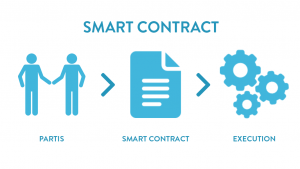Let's Discuss
Enquire NowAs the modern world is moving towards digitization in every respect, the document management system (DMS) is perhaps the most important technology to date for managing and storing documents and other records. Keeping track of all changes and edits to documents, as well as document duplication, can be critical to the flow of ordinary documents, let alone legal ones. Blockchain, in turn, is one of the most promising technologies with the ability to solve these problems. It can present a revolutionary platform for the financial sector, educational institutions and government agencies to keep confidential data safe and secure.
Blockchain
A blockchain is a growing list of records called blocks that are linked together using cryptography. Each block contains a cryptographic hash of the previous block, a timestamp, and transaction data (usually represented as a Merkle tree). The transaction data existed when the block was published to enter its hash. Since the blocks contain information about the previous block, they form a chain and each additional block reinforces the previous ones. Therefore, blockchains are resistant to the modification of your data, as the data in a particular block cannot be changed retrospectively after recording without changing all subsequent blocks. Blockchains are generally managed by a network of peers to be used as a publicly distributed ledger in which nodes share a protocol to communicate and validate new blocks.

Role of Blockchain
Since blockchain is a type of distributed ledger technology, it enables the system to be decentralized. When using central systems, there is always a central authority that controls the system and can possibly change the documents stored in the DMS. With blockchain, companies can be sure that their information is protected and the risk of corruption is completely eliminated.
In a blockchain-based file system, we can instantly check the location of a particular document, who created it and when it was last modified, and detect any attempt at tampering. This is possible, thanks to a unique fingerprint for each element entered in the chain (an ID generated by algorithms) that allows us to identify each file within our scope of action.
Another important feature of blockchain technology (a big advantage for any DMS!) Is immutability: once a new document and information about it has been added to the blockchain, it is impossible to edit, change or delete it. However, this does not mean that the staff will not be able to work with the document afterwards, if they have to edit it, they add the new document and the associated information to the new blocks in chronological order. Other employees can see the original document, check who worked on it and what changes have been made to subsequent versions.
It additionally avoids the classic problem of duplications and also the use of different versions of the same file, since as soon as someone modifies the file, this update will be automatically registered by the system so that no misunderstanding occurs in the management of different files.
Legally valid contracts are usually supported by a physical signature. Unfortunately, manual document processing often leads to human error, and the legal sphere is also prone to it. With the use of smart contracts, blockchain can significantly improve this situation.
Smart Contracts
A smart contract is a computer program or transaction log that’s designed to automatically execute, control or document legally relevant events and actions in accordance with the terms of a contract or agreement. Smart contracts are often considered as a secured stored procedure as its execution and codified effects, just like the transfer of some value between parties are strictly enforced and once a transaction with specific contract details has been stored on a blockchain or distributed ledger it can’t be modified. This is because the actual execution of the contracts is controlled and verified by the platform and not by any server-side program that connects to the platform.The goals of smart contracts are to reduce the need for trusted intermediaries, arbitration and execution costs, loss of fraud, and the reduction of malicious and accidental exceptions.

Role of smart contracts
The conditions of smart contracts are programmed into the system and the contract is executed automatically when the conditions are met. The introduction of smart contracts, therefore, makes it possible to eliminate human errors and to automate otherwise long and routine processes.
The blockchain system fulfils the functions of a reliable timestamp service provider. This provides additional control over the integrity and authenticity of documents and information.
To date, some successful experience has been gained in using blockchain solutions to ensure the integrity and authenticity of documents, information and control information (audit logs) within the short term. So far, there is no practical experience of storing documents and information in blockchain systems. It seems that in the future, the most likely and promising is the development of a system that uses blockchain to meet document management requirements.
Have a project in mind that includes complex tech stacks? We can be just what you’re looking for! Connect with us here.
Disclaimer: The opinions expressed in this article are those of the author(s) and do not necessarily reflect the positions of Dexlock.



